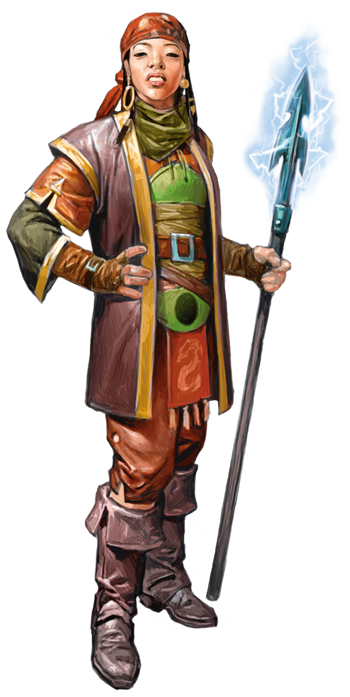 We’ve completed our second full rotation of the twelve classes in the Player’s Handbook, not to mention taken a deep dive into the first 5 levels of D&D’s thirteenth class, the inventive and arcane Artificer! This wave of the Class 101 series will appraise every subclass within the Player’s Handbook and break down each subclass’s strengths, weaknesses, thematic elements, and everything else a player would want to know before playing that subclass. Because of this, you will need to own the Player’s Handbook (or purchase the subclass a la carte on the Marketplace) in order to make full use of this series.
We’ve completed our second full rotation of the twelve classes in the Player’s Handbook, not to mention taken a deep dive into the first 5 levels of D&D’s thirteenth class, the inventive and arcane Artificer! This wave of the Class 101 series will appraise every subclass within the Player’s Handbook and break down each subclass’s strengths, weaknesses, thematic elements, and everything else a player would want to know before playing that subclass. Because of this, you will need to own the Player’s Handbook (or purchase the subclass a la carte on the Marketplace) in order to make full use of this series.
Though we’re currently still looking at subclasses found within the Player’s Handbook in the Class 101 series, several classes including the sorcerer only have two subclasses in that book. We’ll need to go beyond that must-have book to other optional D&D sources. This subclass is the Storm Sorcery origin, which can be found in Xanathar’s Guide to Everything, the first major rules expansion for fifth edition Dungeons & Dragons.
Check out the other guides in the Class 101 series, like the broad overview of the sorcerer class in Sorcerer 101: A Beginner’s Guide to Innate Magic, Sorcerer 101: Draconic Bloodline, and Sorcerer 101: Wild Magic. If you’re interested in playing other classes, check out the entire Class 101 series.
Story of the Storm Sorcerer
She awoke again, sweat rolling down her forehead, as another summer storm passed over Waterdeep. Her heart raced with excitement, though her ardor was twinged with more than a hint of fear. She was young, and her parents had forbade her from venturing out into the storms, ever since they found she had climbed up onto the roof a few weeks ago to watch lightning strike the tallest tip of the God Catcher, one of the city’s famous Walking Statues.
The teenager slipped out of her room and slid down the bannister to the ground floor of her family’s home—it was the quickest, quietest way, but it was also the way that felt most like flying. She’d had dreams of flying ever since she was old enough to remember. She had overheard her parents say once, speaking in hushed tones to her grandmother, that she had been born under one of the heaviest storms to have ever passed over the city, at the exact moment that a thunderclap exploded above their home.
Something about the power and fury of the storm caused her blood to pound. She stood on tiptoes to grab one of her mother’s heaviest cloaks from its hanger and threw it over her, then quietly took the stairs two at a time back up. She scurried to her window and cautiously unlatched it, then looked up to the ivy-covered latticework that climbed past it to the roof. Fat raindrops pelted her face, but she didn’t flinch. The warm summer rain on her face felt natural.
Before long, she was on the roof, the cloak rippling out around her in the wind. She closed her eyes and felt her heart fluttering, jolting slightly when it to hammered harder in unison with the thunderclaps that punctuated the staccato tapping of the rain. She wanted to feel it again—the power she had first felt years ago. She had felt it all her life, but was unable to explain exactly what it was, before her first big storm. It was a tingling in her fingertips, a thrumming in her chest, an indescribable need to be something more than herself. She shuddered as a bolt of lightning cracked the sky, and involuntarily raised her finger, as if to touch it.
Power like she’d never felt before welled up within her, and with a yell of panic and determination, she thrust her palm forward. A crackle of lightning burst from her fingertips, and she gasped and stumbled backward, landing hard on gently pitched roof of the house. She glanced down at her hand, still crackling with energy, and then back up at the sky. It was magic. The storm’s magic.
Her magic.
Storm Sorcery Features
Sorcerers in tune with the thrumming of the storm are conduits for powerful destructive magic—but they are not simply engines of destruction. The storm brings freedom and release just as easily as it brings death. The sorcerer gains four subclass features at 1st, 6th, 14th, and 18th level. You can read all of the Storm Sorcery features in Xanathar’s Guide to Everything. In summary, your subclass features allow you to:
- Speak Primordial, the language of elementals
- Fly whenever you cast a spell of 1st level or higher
- Become resistant to lightning and thunder damage
- Call the wrath of the storm upon nearby creatures when you cast spells of 1st level or higher
- Subtly control the weather around you
- Reactively call lightning upon those who hit you
- Become immune to lightning and thunder damage
- Grant yourself and your companions the power of flight
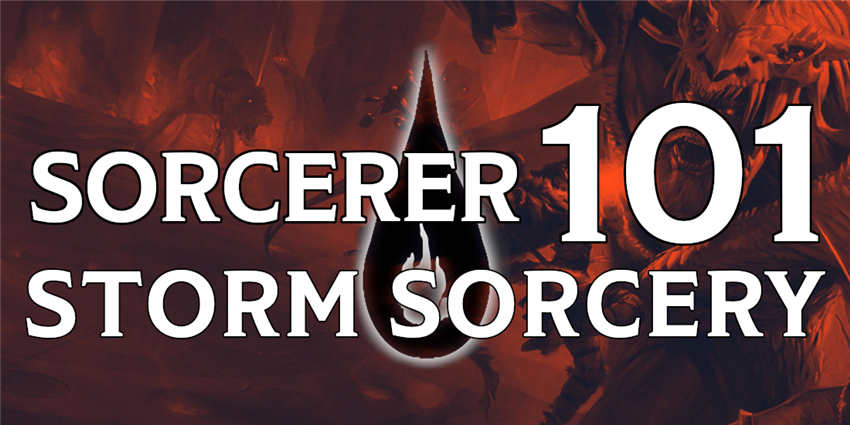
Benefits of Storm Sorcery
The Storm Sorcery subclass offers sorcerers an interesting power right from 1st level: the ability to fly. Even though their flight is limited, just a mere 10 feet and only when you cast a 1st level spell, flight at early levels is a powerful boon. In fact, one of the most powerful aspects of this feature isn’t that it lets you move without walking, but that it lets you move without provoking opportunity attacks. For a squishy, 1st-level sorcerer, being able to zip out of reach of one, two, or maybe even more monsters swarming around you is an enormous boon. Normally you would have to spend your action to Disengage, but this subclass allows you to still actively contribute to defeating your foes by casting one of your few, powerful spells.
This feature is just the foundation of a set of interesting abilities that the storm sorcerer gains as they level up. A storm sorcerer wants to be in the thick of combat, as evidenced by class features that let them deal damage in a close burst around them when they cast spells, and that let them reactively deal damage to foes that strike them. Taken together, this subclass’s Tempestuous Magic, Heart of the Storm, and Storm’s Fury features encourage a hit-and-run playstyle that sends your sorcerer into the heart of combat to knock foes around with magic, only to flee, but then still have juice left to blast away any foe that would pursue you.
Ultimately, you also gain resistance and immunity to your damage types of choice. This is a useful boon against some monsters, meaning they’ll be more useful in some campaigns than others. In this way, a Storm Sorcerer would be well-suited to Storm King’s Thunder, where lightning damage abounds, but perhaps less powerful in an adventure like Waterdeep: Dragon Heist, where it’s more infrequently used.
Drawbacks of Storm Sorcery
The greatest problems with the storm sorcerer are endemic to the sorcerer class itself. Namely, the sorcerer’s limited spells known and inability to learn new spells like a wizard might add spells to their spellbook can make you feel like your role in the party is incredibly narrow and predefined, with little room to rework your arsenal if you don’t like your pigeonhole. The Storm Sorcery subclass encourages you to take offensive spells that deal boatloads of lightning and thunder damage, but unless you’re careful with your spell selection, you may find yourself lacking the ability to do much of anything else.
Likewise, your class’s inability to cast spells as rituals is a minor drawback that makes it less useful for you to learn spells like detect magic, since you can’t cast them as a ritual. Try to have a clear idea of what you want to be able to do in-combat, during exploration, and during social interactions when you start playing a sorcerer; it will help you in the long run.
Suggested Build
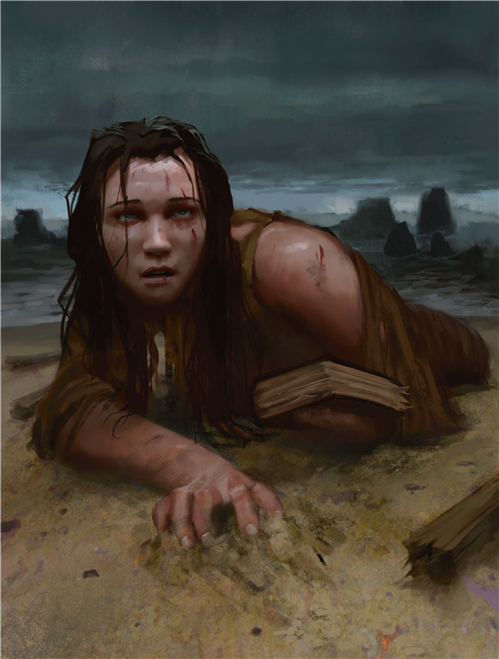 As a sorcerer, you get to choose your Sorcerous Origin at 1st level! While this means that you get to reap the benefits of your subclass from the very beginning, it also means that you don’t have any time to “settle in” to your role and figure out how you want to play your character before making this big decision. Consider your subclass carefully!
As a sorcerer, you get to choose your Sorcerous Origin at 1st level! While this means that you get to reap the benefits of your subclass from the very beginning, it also means that you don’t have any time to “settle in” to your role and figure out how you want to play your character before making this big decision. Consider your subclass carefully!
You should choose a race that improves your Charisma score and either your Dexterity or Constitution scores. As a sorcerer, Charisma is your most important ability. Your spells are powered by your own confidence, force of personality, and determination—rather than any sort of formal study—which is represented by your Charisma. Dexterity helps give you a vital boost to your Armor Class, since you won’t be wearing much armor. On the other hand, Constitution does double duty by making it easier to hang onto spells that require concentration in addition to improving your hit points. Either choice is useful!
Tieflings make excellent sorcerers, since they boost your Charisma and also give you a few extra spells that you can cast as a racial ability rather than learning through your class. Half-elves are also great, since they come with a big Charisma boost and let you boost two other ability scores of your choice. Lightfoot halflings are both dexterous and charismatic, and their other racial traits will serve you well. If you don’t mind hating the sun, playing as a drow is an attractive proposition, since they also give you a boost to both Charisma and Dexterity, as well as a few extra spells. And, as always, the variant human race is never a bad pick.
The Class 101 series tries not to suggest options that aren’t in the Player’s Handbook or the supplement that the current week’s spotlighted subclass is from (in this case, Xanathar’s Guide to Everything) but it should be said that genasi, particularly air or water genasi, are well-suited thematically to this subclass. They’re available in the free Elemental Evil Player’s Companion source.
As usual, your character’s background is up to you. Sorcerers can come from anywhere, since their magic spontaneously appears as a result of some arcane confluence. Unlike the Draconic Bloodline sorcerer, your magic powers aren’t necessarily related to your genealogy, though you may have another famous storm sorcerer in your family tree. As such, any background suits you, and can make an equally interesting story.
Choose EQUIPMENT instead of GOLD at the end of character creation. Since you’ll probably be choosing at least one ranged damage-dealing cantrip, you can safely forgo choosing a light crossbow in favor of a simple weapon, like a quarterstaff or a dagger. Whether you choose an arcane focus or a component pouch is purely a flavor choice (do you like using a wand or a magical crystal to focus your arcane power into spells, or do you want to use eye of newt and toe of frog to make magic happen?). If you think you’ll be in dungeons a lot, take a dungeoneer’s pack. Otherwise, go explorer. Finally, you get two extra daggers. Keep those hidden, just in case!
Spells
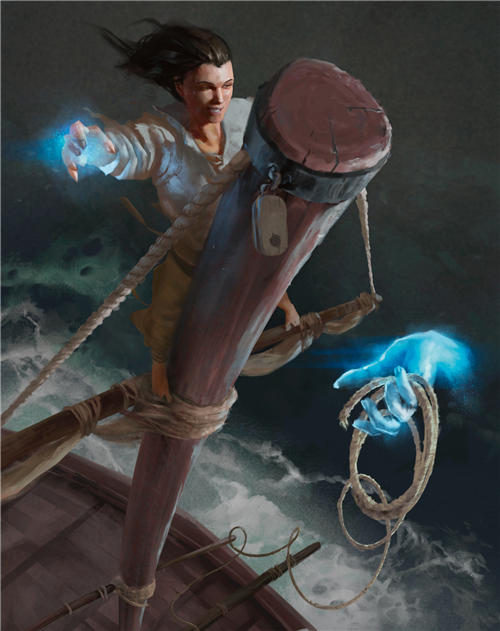 Choosing spells is a big deal for any caster, but you need to be particularly choosey. Sorcerers don’t learn many spells over the course of their career, so you’ll want to get pretty familiar with your spells. You’ll be using them for a long time. Unless, of course, you take full advantage of spell swapping—that is, trading an old spell out for a new one when you gain a level.
Choosing spells is a big deal for any caster, but you need to be particularly choosey. Sorcerers don’t learn many spells over the course of their career, so you’ll want to get pretty familiar with your spells. You’ll be using them for a long time. Unless, of course, you take full advantage of spell swapping—that is, trading an old spell out for a new one when you gain a level.
You get four whole cantrips at 1st level, so you still have a handful to choose from! These are all the sorcerer cantrips from the Player’s Handbook that you can choose from. You should choose at least one long-range damage cantrip, one close-range damage cantrip, and two others of your choice that you can use for utility. Since this subclass is from Xanathar’s Guide to Everything, it’s important to look at the sorcerer cantrips from that book as well; thunderclap is a useful one for you, both because of its appropriate damage type and because it encourages you to get into the fray!
With your cantrips chosen, you now get to select two 1st-level spells that you know. You’ll learn one new spell every level until 10th level, and then one new spell every other level after that until 17th—at which point you’ll stop learning spells entirely. Choose wisely! You’ll want one spell marked OFFENSE, and one spell marked either DEFENSE or SOCIAL, depending on how you want to play your character. All OFFENSE spells have their damage type labeled as well, to help you pick which is best for your Storm Sorcery.
- Chaos bolt (OFFENSE)
- Charm person (SOCIAL)
- Disguise self (SOCIAL)
- Fog cloud (DEFENSE)
- Ice knife (OFFENSE)
- Mage armor (DEFENSE)
- Magic missile (OFFENSE)
- Thunderwave (OFFENSE)
- Shield (DEFENSE)
Feats
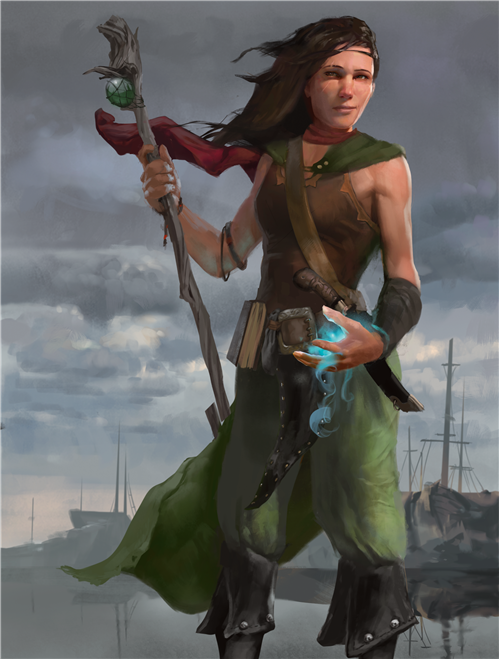 Once you’ve improved your Charisma score to 18 or 20, you can increase your power with a few useful feats. The following feats are good picks for storm sorcerers, and will improve your reliability in your own desired area of expertise:
Once you’ve improved your Charisma score to 18 or 20, you can increase your power with a few useful feats. The following feats are good picks for storm sorcerers, and will improve your reliability in your own desired area of expertise:
Inspiring Leader. Your already-high Charisma makes you an excellent candidate to be the social face of your party. As your character becomes more confident in their own abilities, having them become a leader that inspires your allies to great deeds is an excellent story beat, with some good mechanics attached.
Ritual Caster. Unlike many other spellcasters, sorcerers can’t cast spells as rituals. They feel their spells intuitively, so the complexities of rituals are beyond them. This feat, however, lets you invest in a spellbook for ritual spells—perhaps as the result of wizards trying to tutor you in an attempt to control your wild magic. This precludes the need to spend your precious spell slots (and precious spells known) on ritual staples like detect magic and find familiar.
Tough. You’re a sorcerer who wants to get into the thick of combat, using close burst area of effect spells and cantrips while making the most of your subclass features. You also have a d6 Hit Die, so having some extra hit points couldn’t hurt. This feat is one way to make that happen.
War Caster. Though often suggested for clerics and paladins, this feat works quite well with the Storm Sorcery subclass. Since you want to be constantly hitting-and-running from your foes, the ability to use your spells or cantrips (like shocking grasp) to make opportunity attacks is a huge boon. Being able to hang onto your concentration spells more reliably is a nice bonus, too!
If you want more advice for building a sorcerer, check out Sorcerer 101. Have you ever played a storm sorcerer? What advice would you give to players that want to play this subclass? Come back next week as we explore the eldritch power of the Great Old One warlock patron!
Create A Brand-New Adventurer Acquire New Powers and Adventures Browse All Your D&D Content
 James Haeck is the lead writer for D&D Beyond, the co-author of Waterdeep: Dragon Heist, Baldur's Gate: Descent into Avernus, and the Critical Role Explorer's Guide to Wildemount, a member of the Guild Adepts, and a freelance writer for Wizards of the Coast, the D&D Adventurers League, and other RPG companies. He lives in Seattle, Washington with his fiancée Hannah and their animal companions Mei and Marzipan. You can find him wasting time on Twitter at @jamesjhaeck.
James Haeck is the lead writer for D&D Beyond, the co-author of Waterdeep: Dragon Heist, Baldur's Gate: Descent into Avernus, and the Critical Role Explorer's Guide to Wildemount, a member of the Guild Adepts, and a freelance writer for Wizards of the Coast, the D&D Adventurers League, and other RPG companies. He lives in Seattle, Washington with his fiancée Hannah and their animal companions Mei and Marzipan. You can find him wasting time on Twitter at @jamesjhaeck.








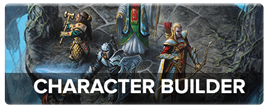
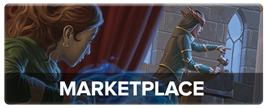
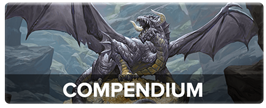
-
View User Profile
-
Send Message
Posted Apr 8, 2021Storm Sorcerer needs an update. My main complaint about this subclass is that you don't automatically gain any thematic spells, unlike newer subclasses like Aberrant Mind or Clockwork Soul. It would be nice if you automatically gain some storm-themed spells like lightning bolt, call lightning, or gust of wind. The lack of thematic spells makes this class seem underpowered compared to newer subclasses. D&D always has these issues, the newer subclasses sometimes seem much better than the older subclasses, because new ideas are born and used with new content, but those new ideas didn't exist when the older content was developed. All sorcerer subclasses should come with extra spells, it would make sense, and compensate for the sorcerer's lack of spells.
-
View User Profile
-
Send Message
Posted Apr 8, 2021Full agreement. All of the PHB subclasses frankly should be re-visited and brought to similar design and power budget philosophies of the later classes. This includes things like subclass spells for all Sorcerers and subclass abilities on Warlock having multiple uses by proficiency bonus rather than just once a short rest for instance.
-
View User Profile
-
Send Message
Posted Apr 8, 2021The thing you said about Warlock isn't really a problem. Many classes and subclasses have abilities that have only one or two uses per short rest, and multiple uses per long rest. For warlock, one use per short rest makes sense, because warlocks already rely on short rests. Adding more abilities that recharge every short rest is good, because it allows warlocks to renew almost all their key powers within one two-hour short rest.
The issue is that the older subclasses never get updated, making the newer subclasses more powerful. That's because the idea of thematic spells was introduced in TCoE, one of the latest books, but because of this, subclasses in XGtE, PHB, or SCAG, don't have features like extra spells. This puts favor in newer content over older content. I think if a generic idea is introduced in a newer content, like thematic spells, the older content should be updated to include those new ideas. That would help to improve balancing, adding reasons to play any type of subclass, new or old.
-
View User Profile
-
Send Message
Posted Apr 8, 2021That's one difference of sorcerers compared to wizards, even though they are similar. Sorcerers get the exact same spell list, with one unique spell, chaos bolt, and much less of the utility spells.
-
View User Profile
-
Send Message
Posted Apr 8, 2021I disagree that the Warlock abilities aren't a problem. Warlock as a class in general and the PHB subclasses more specifically are heavily balanced around the idea of at least 2 short rests in a day. That is how their power budget is spent and allocated. Unfortunately I have found this to rarely be the case in practice. Usually one of two situations seem to happen at all the tables I have played at- 1 the DM prepares lots of RP with one large combat encounter or 2 the DM prepares a number of ongoing encounters specifically designed to string out the players and make a short rest a serious hindrance. Either way the Warlock is left with either one huge encounter where after the 3rd round they have used a huge number of their resources and just end up spamming EB or they are rationing resources that are supposed to be recharged twice a day and left ending up spamming, yep you guessed it, EB.
Changing things like Fey Presence, Misty Escape, Dark One's Own Luck and Entropic Ward to have a number of uses equal to proficiency bonus (or 1/2 PB) that recharges on a long rest makes it so they are not in conflict with their party about short rests and gives them greater control and flexibility over their usage.
-
View User Profile
-
Send Message
Posted Apr 9, 2021Warlocks do depend on short rests, so they are good characters to play if your DM will allow your party to take at least 2 or 3 short rests per day. Other classes have abilities that recharge every short rest, like the Fighter's Second Wind, Monk's Ki, and Clerics and Paladins Channel Divinity, so it would be nice if all DMs would allow at least 2 short rests per day, and one long rest.
One way to solve the problem of limited spell slots is to use spells with a long duration, like hex or armor of agathys. Eldritch Invocations can make up for this to, since it allows you to cast certain spells for free. Having spells that scale well is useful, because all of the warlock's spells must be cast at the highest possible level.
Another way to help with this issue is learning invocations that enhance eldritch blast. If you can learn a couple of these invocations, you can rely of EB most of the time, and save your precious spell slots for when you really need them. Agonizing blast is a must-have, because it allows you to use EB like a fighter using a heavy crossbow.
That's the thing about warlocks, you use your Eldritch Invocations for utility, and EB for some of the easier combat encounters. You only use your pact magic slots when you have to. And of course, playing a warlock requires some cooperation with your DM, making sure they'll allow the party to take a few short rests per day.
-
View User Profile
-
Send Message
Posted Apr 9, 2021I mean yeah it would be ideal if the DM and other party members would recognize that the game somewhat depends on several short rests but I live in the practical. It's frankly an oversight in game design to balance an entire class around a mechanic that most tables don't embrace. And clearly WOTC sees this because Fathomless and Genie warlock abilities AREN'T built as heavily around short rest mechanics. This is a clear admission that the earlier class designs were flawed otherwise why change if it was working well?
All I am saying is it would be nice for an official Errata/Optional Rule Change to correct this. Not sure why you seem to think I don't know how to work around it. I am pointing out that I shouldn't have to lol.
-
View User Profile
-
Send Message
Posted Apr 9, 2021My fix for "no shorts" GMs is to ask when do we eat, when do we stop doing a forced march, and so on. How many sessions are you actually active for 16 hours straight? Very few, but no one states that explicitly. By bringing it up, almost everyone will admit that you actually are taking short rests, but it wasn't recognized as such.
-
View User Profile
-
Send Message
Posted Mar 1, 2022I feel like the PHB, DMG, and MM should all be free, because those are what make up the core D&D set. You'll get to play the base game for free, and you pay to upgrade your game.
-
View User Profile
-
Send Message
Posted Mar 1, 2022Unfortunately, technically the ‘base game’ is only the basic rules.
It would probably be mostly or entirely free if WotC was less strict, but at the moment doing that would mean getting sued.
-
View User Profile
-
Send Message
Posted Mar 1, 2022In my experience it's usually the group rather than the DM that causes few short rests; a DM may disallow them in certain cases (too many enemies around etc.) but it's the group that needs to ask for them.
Best fix in that case is to make classes that don't care about short rests more dependent upon them; you'll find you'll be taking a lot more short rests once the Rogue is told they need to short rest to get their Sneak Attack uses back. 😈
-
View User Profile
-
Send Message
Posted Mar 22, 2022Fifth. Nice spells
-
View User Profile
-
Send Message
Posted Mar 22, 2022I think there will be some errata. The expanded spell lists for clockwork and aberrant really leave the other subclasses in the dust (excepting the divine soul... Maybe).
-
View User Profile
-
Send Message
Posted Mar 22, 2022Two spells per level would make more sense. It would bring it into line with Aberrant Mind and Clockwork Soul.
-
View User Profile
-
Send Message
Posted Mar 22, 2022If you're interested, I released a homebrew update to the sub-class a little while ago called Tempest Sorcery, which adds the following spell list:
Tempest Spells
In addition, the spells Elemental Bane and Storm of Vengeance are added to your sorcerer spell list.
I was somewhat limited by the D&D public homebrew restrictions (can only add spells from the Basic Rules of Elemental Evil Player's Companion), and omitted a few things such as Shatter which can already be taken by a Sorcerer, in favour of things that can't, though there is some overlap at some levels (no good choices outside the sorcerer list). I think it's a nice mix, though 3rd level is a little wind focused.
-
View User Profile
-
Send Message
Posted Mar 22, 2022Well, Divine Soul does have a expanded spell list: everything on the Cleric list. Which is better than the other two because not only is it far more spells, it also grows with every new Cleric spell, while the others are locked for all time. Agreed that all the Sorcs & Rangers should have a subclass specific additional spell list.
-
View User Profile
-
Send Message
Posted Oct 3, 2022So that aged... poorly, lol. I think it's still reasonable to expect to pay for content, regardless of where you get it, though. I will say I think getting a code for the online version would be nice if you buy the physical copy, but I know that's probably not going to happen, and it'd really just be more of a "oh cool" kind of thing.
-
View User Profile
-
Send Message
Posted Nov 3, 2022So maybe there's some sort of feature I don't know about, or maybe it's just me, but when I take this as a subclass, there appear to be higher slot levels than I should be rightfully entitled to. I have two level 5 slots at level 8. IIRC, the first one shouldn't even happen until level 9. What's up with that?
-
View User Profile
-
Send Message
Posted Nov 6, 2022The original UA_Waterborne used to have these additional spells:
They scrubbed them when Xanthar's launched. Not sure why, without them, the subclass is underwhelming. Not having access to "storm" spells seems contrary to the intent of the sub-class. I worked with my DM to use the UA version. Just makes more sense, especially when compared to the other Sorcerer sub-classes, all of which get additional spells.
Link to UA: https://media.wizards.com/2015/downloads/dnd/UA_Waterborne_v3.pdf
WOTC, please fix this.
-
View User Profile
-
Send Message
Posted Jul 16, 2023"...thunderclap is a useful one for you, both because of its appropriate damage type and because it encourages you to get into the fray!"
Actually, Thunderclap is no more useful for a Storm Sorcerer than any other caster in melee, because Storm Sorcerers gain no bonus effect by casting cantrips with lightning or thunder damage. If surrounded in melee, it is better to cast Thunderwave to potentially knock the enemies back, then GET OUT OF THERE with your Tempestuous mini-hop. Or use Misty Step and teleport out, like any other caster.
Storm Sorcerers play differently than any other sorcerer. The multitude of guides for sorcerers really don't apply to Storm Sorcerers. If a Storm Sorcerer hangs back and blasts, you wont really need or use Tempestuous Magic for mobility. You also won't trigger Heart of the Storm for that tiny bit of extra damage. You have to think differently with a Storm Sorcerer. You have to get into short range. You have to save your bonus action to TM out of there. You have to use levelled spells more than cantrips. You have to have some defences in place for short range combat, like Mage Armor, Shield, or even Mirror Image. While it is good to have spells with lightning and thunder, you don't need all of them. Thunderwave is useful at all levels because it scales well, and has short range AoE. Shatter gives some utility for damaging items like doors, structures, ships. Lightning Bolt is nice because it is 100ft long and it's easy to avoid hitting your fellow party members when you use it. Thunderstep is okay, but Misty Step is more useful, and you really have a lot of limits on your spells.
For Metamagics, if you have AoE spells, consider Empowered or Careful spells. Transmuted spell is also useful for changing your lightning or thunder damage when you encounter resistance or immunity. Subtle spell isn't really your style, but this may make it even more surprising when you pull it off. Twinned isn't as good since you'll have more AoE spells. Quickened isn't as useful since you need your bonus action for Tempestuous Magic.
Hope this helps.